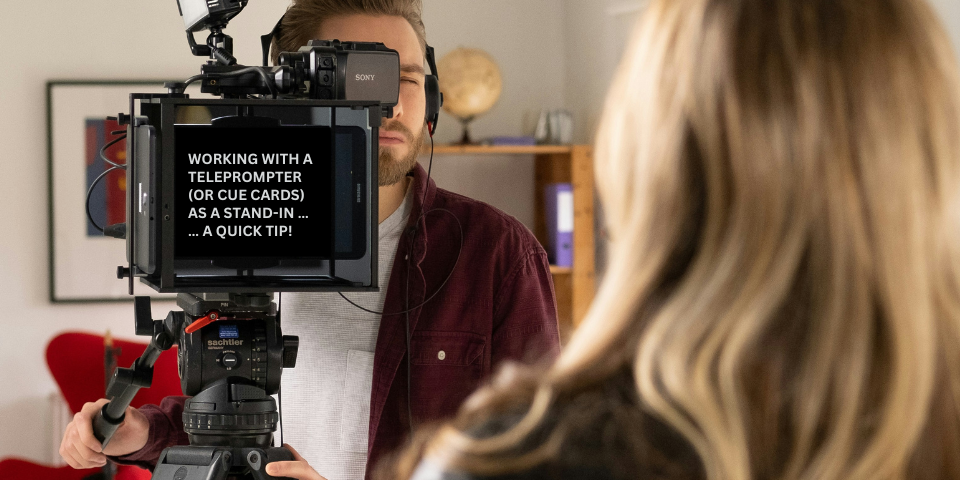You may have experienced this before when you were standing in:
You’re standing in the middle of set with the camera on you. The crew is busily dressing the set. The set dressers are bringing in furniture that had been removed, though things seem a little bit off from before. The props masters are laying down props that were handled in the scene, though they’re laying down items in a different arrangement than when your actor handled them. Your blocking may have slightly changed from an earlier setup, but no new marks have been put down and the old marks remain.
What do you do in these kinds of situations?
While there is no absolute answer on what to do in these types of situations, a little guidance can go a long way. Here are some principles I use when standing in and seeing something amiss on set.
A Note about Responsibilities
First of all, it should be noted that on a film or television set, crew members have far-ranging but ultimately limited responsibilities. Labor is divided up, and the department in which you work dictates what kinds of service you perform for a production.
For example, the camera department handles the cameras, the sound department handles the sound equipment, the props department handles the props, etc. You probably won’t see, say, a grip helping the props department with props-related work, or a props master helping a grip with carrying equipment. You are only responsible for the areas your work covers.
This means that as a stand-in, you are responsible for stand-in work. You are not responsible for dressing the set or setting props, nor are you responsible for continuity with respect to where they are placed in a shot. You are not responsible for laying down marks or moving marks where your actor may land. You are hired to stand in for your actor: to stand or sit or lie where your actor does in a scene, and to execute any blocking your actor performs in a scene (along with a few other responsibilities).
On “Helping”
In your neighborhood, you might be inclined to help to a neighbor in need. You might help lay some cement down in a driveway, pick up the mail from the mailbox or newspaper from the driveway, walk the dog, or some other courtesy when you have a spare hand to lend. You might see this as “being a good neighbor,” and you might think poorly of a neighbor who doesn’t help another neighbor in need.
Helping others — particularly when you are standing in and when the “others” are crew members — isn’t entirely encouraged when you work on a television or film set. As a general principle, when you are standing in, it is a good idea to mind your own business with respect to the setup of a shot and the business of other crew members. Crew members are professionals, and usually they are very good at their jobs. Separate departments are responsible for set dressing, props, and laying down marks, and “helping” these departments with their work may be akin to invading their territory. There may even be union rules in place regarding who does what kind of work on a set, and your “helping” could be a violation of those rules.
Your “help” may even hinder their work. A set dresser may be directed to, say, dress the set in a particular way, directions you might not have been privy to. If your idea of how the set should be dressed proves wrong, the set dresser may get the grief for that dressing. In general, it is best not to “help” in the neighborhood sense of the term.
When Something Is Amiss and No One Seems to Be Doing Anything about It
Still, there will be times on set when you know something isn’t quite right and no crew member seems to know. For example, perhaps the table at which your actor is sitting is now wobbly. Perhaps you are being excused from set by the 1st AD but your new placement in the shot hasn’t been marked. Or perhaps your actor has arrived to take your place on set but the actor’s prop is nowhere to be seen.
When you are in such situations, figuring out whom to tell can be very tricky. You probably could opt not to say anything — and let other departments responsible over the matter take any heat for the errors. But in the spirit of working as a team on a production and getting the shot, you might not want to do that. Whom should you tell?
Whom to Tell When Something Is Amiss
As a stand-in, your immediate bosses are the assistant directors. More than likely the 2nd 2nd AD is your contact person, and if that crew member is not immediate to you, the 1st AD might be your next best option. If you see something amiss on set that the other crew members haven’t noticed, you might opt to inform the 2nd 2nd AD or the 1st AD of the issue. This crew member can then contact the appropriate department to make the adjustment.
Have you not been newly marked? Telling an AD will likely get the AD to tell the camera department to remark you. Is the set dressing unstable for your actor? Telling an AD may lead to the AD telling the set decoration department to address and fix the issue. Is a prop needed during a camera setup? Again, telling an AD may lead to the AD contacting the props department.
When It Might Be Okay to Talk to a Department Directly
If you’ve developed a rapport with crew members in a particular department, you may feel comfortable to skip communicating to an AD when something is amiss and communicate with that crew member directly about the issue.
For example, if the table you’re sitting at is wobbly and the set dresser you know well is next to you, you might politely say something to the set dresser about the problem. If the set dresser comes to adjust the table, great!
Similarly, if you’re being excused from set and haven’t been remarked, you might tell the camera assistant that you need a new mark. If you get one, wonderful!
But sometimes things still don’t get done. If that’s the case and you’re being excused from standing in, rather than tell your friendly crew member about the issue again, it might be a better idea to tell an AD to have the AD address the issue with the particular department.
In Conclusion
Hopefully when you are working as a stand-in, you won’t be working with a crew that dresses the set wildly differently every time, doesn’t lay out props correctly, or doesn’t remark you after you move. That is, hopefully you can mind your own business and focus on standing in. But should you find yourself in a situation when something is amiss and no one seems to notice it, going through the ADs is generally the way to go.
Do you favor going through the ADs when something is amiss? Do you have a different recommendation? Do you have any stories of when you addressed an issue in a setup? If so, share below!






I have re-marked myself before, in cases where it seems really important and I wasn’t able to tell a camera operator or assistant. This is one of the trickiest situations, because you may have to stay in place to remember where your new mark is and there may not be anyone close enough to you that you can ask for help. I don’t make a habit of this, but it’s never been a problem when I’ve done it. Great advice in this article – thanks!